🌿✨ Haworthia obtusa — The Jewel of Succulents
Haworthia obtusa is a stunning, slow-growing succulent known for its strikingly translucent leaf tips, making the rosette look like it’s crafted from crystal or glass. Native to South Africa, this small and compact species is part of the Asphodelaceae family, closely related to other Haworthias and Aloes.
Its beautiful, chubby, and rounded leaves, coupled with a low-maintenance nature, make it highly desirable for both beginner and experienced succulent enthusiasts.
🌿 Botanical Overview
Scientific Name: Haworthia obtusa
Family: Asphodelaceae
Common Names: Window Haworthia, Haworthia obtusa
Origin: Eastern Cape Province, South Africa
Growth Habit: Small, clumping rosette
Size:
Height: 2–4 inches (5–10 cm)
Width: 3–5 inches (8–12 cm)
🍃 Appearance
Leaves:
Thick, fleshy, and rounded with a smooth texture
Leaf tips are semi-transparent, giving the “windowed” effect
The color is usually bright to deep green, sometimes with bluish or glassy hues
Compact rosette structure
Flowers:
Small, tubular white or pale pink flowers
Bloom on tall, thin flower stalks (inflorescence) during the spring or summer
Flowers are not the primary attraction — the foliage is the real star
☀️ Light Requirements
Indoors:
Prefers bright, indirect light
Near east or north-facing windows or slightly filtered south-facing spots
Direct sun, especially midday, can cause leaf scorching or color fading
Outdoors:
Thrives in partial shade or dappled sunlight
Avoid direct harsh sun, especially in hot climates
Too little light can cause the plant to stretch (etiolate), losing its compact rosette form.
🌡️ Temperature & Humidity
Temperature:
Optimal range: 18–27°C (65–80°F)
Can tolerate down to 5°C (41°F), but best kept above 10°C (50°F)
Humidity:
Prefers dry to moderate humidity
Well-suited for indoor environments with standard humidity levels
Ensure proper air circulation to prevent fungal issues in humid settings.
💧 Watering Routine
Active Growth (Spring to Autumn):
Water when the top 1–2 inches of soil are dry
Typically every 10–14 days
Water thoroughly, allowing excess to drain completely
Winter Dormancy:
Reduce watering to once a month or less
Keep soil almost dry but don’t let the plant dehydrate completely
🚫 Avoid getting water trapped in the rosette center, as it may cause rot.
🌱 Soil Requirements
Type:
Well-draining soil is essential
Use:
50% cactus/succulent potting mix
25% perlite or pumice
25% coarse sand or akadama for extra drainage
pH: Slightly acidic to neutral (6.0–7.0)
🌾 Fertilizing
Feed during the growing season (spring and summer):
Use a balanced, diluted liquid fertilizer (half strength) once a month
Avoid fertilizing in autumn and winter
Too much fertilizer can cause weak, elongated growth.
✂️ Maintenance & Pruning
Minimal maintenance required
Remove dried or dead leaves from the base
Clean dust off leaves occasionally to improve photosynthesis
🌿 Propagation
Offsets (Pups):
Haworthia obtusa produces small pups around the base
Separate pups when they have formed some roots
Let the offsets callous for a day or two before planting
Leaf Cuttings:
Less reliable but possible
Allow cut leaves to dry and callous before planting in dry soil
Seeds: Rarely propagated by seeds due to slow growth.
🛡️ Common Problems
Overwatering: Causes root rot and mushy leaves
Underwatering: May lead to shriveling
Pests: Susceptible to:
Mealybugs
Spider mites
Fungus gnats (in overly wet soil)
Treat pests with neem oil, insecticidal soap, or systemic treatments as needed.
🎍 Decorative Use
Perfect for:
Desktop and tabletop displays
Terrariums (open types only)
Miniature gardens
Succulent arrangements
Its glassy, translucent leaf tips make it a jewel-like addition to any indoor garden or succulent collection.
✅ Conclusion
Haworthia obtusa is a charming, low-maintenance succulent that offers visual intrigue through its unique windowed leaves. With bright indirect light, minimal watering, and well-draining soil, it will stay healthy and stunning for years. Its slow growth and manageable size make it ideal for small spaces, apartments, or indoor collections.





Reviews
There are no reviews yet.